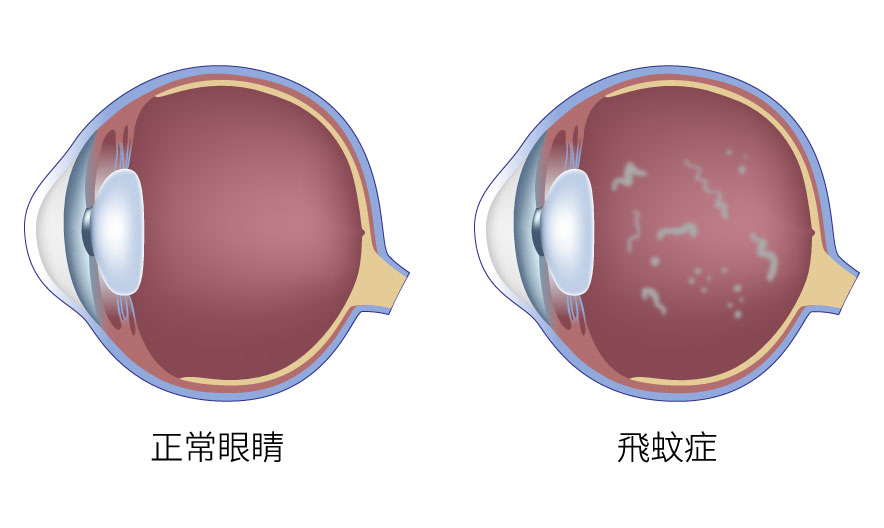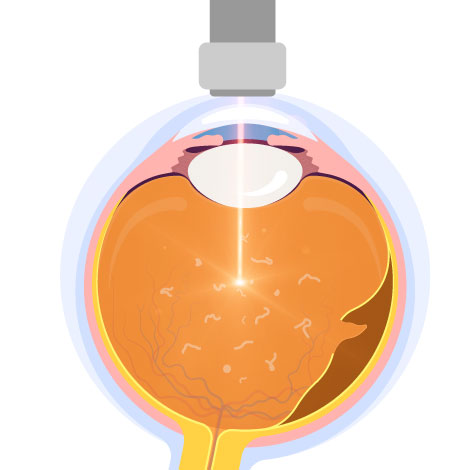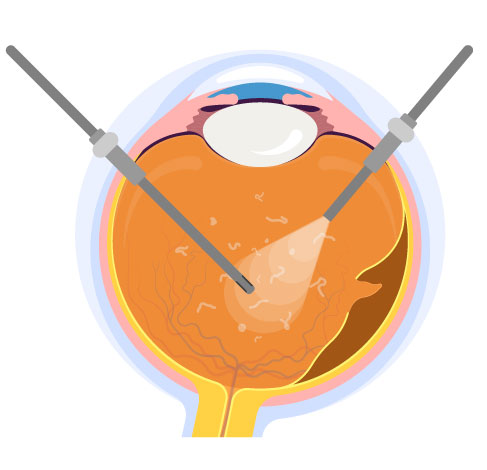


What are Eye Floaters?
Do you see any floaters in your field of vision, e.g. small black spots or blotches, threads, fragments of cobwebs? These are all symptoms of eye floaters.
飛蚊症是當眼內透明的玻璃體日益退化,玻璃體會液化而變得混濁,形成細小殘屑在玻璃體裡漂浮。當光線進入眼睛,經過折射濁化的組織會被投射到視網膜上,我們看到的就是浮游物的影子。成因包括:玻璃體退化、玻璃體脫離、視網膜出現裂孔等。但若看到閃光或突然大量飛蚊的出現,這些症狀可能代表視網膜有脫落的可能性,應立刻求醫及做眼睛檢查,眼科專科醫生會作出適合調理方式,以避免永久性的視覺損失。
Causes of Eye Floaters

Vitreous degeneration due to aging
Aging of the eyes is the most common cause. As age increases, the vitreous body of the eye degenerates and shrinks, gradually detaching from the originally tightly bound retina, and the vitreous body fibers inside may become turbid, projecting many small black dots on the retina, becoming a common sight for people with floaters.

Vitreous detachment from the retinal surface
Retinal detachment can cause floaters. If floaters are caused by retinal problems, you must seek medical attention immediately, otherwise it may lead to blindness in severe cases.

Retinal holes
A tear in the retina can cause floaters. If floaters are caused by retinal problems, you must seek medical attention immediately, otherwise it may lead to blindness in severe cases.

Diabetes
Diabetic patients are prone to new and abnormal blood vessels on the retinal surface. The blood vessels are fragile and prone to rupture, making the vitreous hemorrhage and retinal damage prone to blurred vision, making them more susceptible to floaters.

Deep myopia
The deeper the degree of myopia, the longer and longer the eyeball will become, and the tissue in the eye will be stretched, thinned, and even ruptured, thereby increasing the risk of retinal rupture and detachment, causing floaters.

Eyeball hemorrhage
Eyeball hemorrhage, also known as hemorrhagic floaters, as the name suggests, is caused by retinal hemorrhage, causing dense black spots to appear in front of the eyes, forming floaters.

Eye inflammation
If your eyes have been traumatized or inflamed, impurities may enter the vitreous and cause "floaters" to be seen in your eyes.
Symptoms of Floaters
According to patients' descriptions, common symptoms of floaters include: black spots in front of the eyes, black mesh-like floating objects, flashes of light, and a veil in the field of vision. These symptoms are particularly noticeable in brightly lit areas or against a white background. If the symptoms of floaters increase significantly, you should see an ophthalmologist immediately for a detailed eye examination.

Dark spots

Floating cobwebs

Flashes in vision

Veil crossing vision
飛蚊症調理方法
一般情況下,只要習慣與浮游物共存,日常生活不受影響,便不需要調理。若浮游物太大或太多,飛蚊症突然發作或閃光,以致視力造成損害時,建議應盡快找眼科專科醫生進行咨詢及手術或激光調理移除。另外亦建議飛蚊症患者每半年至一年進行一次視網膜檢查,如果中間有惡化症狀就要提早回診,並接受全面檢查。
激光調理
用於較大和集中的玻璃體浮游物並擊碎成更小的碎片,以改善及消除飛蚊症狀。過程中不會痛,會於局部麻醉下進行。但不是所有人都適合激光調理,例如:浮游物較鬆散或位置太接近黃斑或晶體,便不宜進行,以免導致白內障或黃斑受損等併發症。

Vitrectomy
The vitreous inside the eye is removed through a small incision and replaced with a solution to maintain the eye's shape. Vitrectomy does not necessarily completely remove floaters, and new floaters may form if the surgery itself causes bleeding or retinal tears.


It is crucial to have regular eye examinations so that your doctor can be aware of any changes and help detect eye floaters and other abnormalities.
Floaters FAQ
Why do "floaters" appear?
When the transparent vitreous body in the eye gradually deteriorates, the vitreous body will liquefy and become cloudy, forming small debris floating in the vitreous body. There may also be flashes of light or a sudden large number of floaters due to retinal detachment, so regular eye examinations are required to follow up on the condition of the eyes.
Do floaters disappear or heal on their own?
Eye floaters do not go away over time, but they do become less noticeable and settle at the bottom of your eye.
Do eye floaters affect my vision?
In general, they do not affect the visual acuity and you can get used to floaters. If you see flashes or a sudden appearance of many floaters, these symptoms may indicate retinal detachment, which can be serious enough to cause permanent visual loss.
Can "floaters" be removed surgically?
There are 2 surgical options:
激光調理
激光調理用於較大和集中的玻璃體浮游物並擊碎成更小的碎片,以改善及消除飛蚊症狀。但不是所有人都適合,例如:浮游物較鬆散或位置太接近黃斑或晶體,便不宜進行,以免導致白內障或黃斑受損等併發症。
Vitrectomy
The vitreous humour is removed through a small incision and replaced with a solution to maintain the shape of the eye. Vitrectomy does not necessarily remove the floaters completely, and new floaters may form if the surgery itself causes bleeding or slash in the retina.
How to distinguish physiological and pathological floaters?
Physiological floaters:
- Normal physiological changes in the vitreous body
- The vitreous body has congenital impurities in it
Pathological floaters:
- Retinal tears, peeling, punctures, and degeneration
- Vitreous hemorrhage
- Macular degeneration
- Eye bleeding and inflammation caused by diseases such as diabetes, hypertension, and ocular stroke
Why are people with diabetes more likely to have floaters?
Diabetic patients

